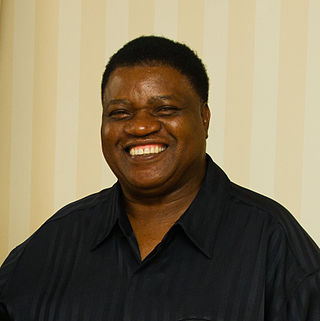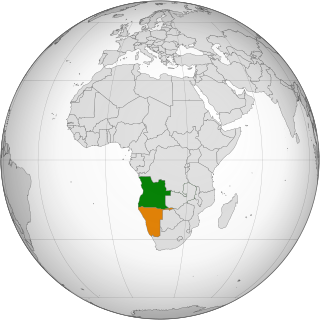Related Research Articles
The history of Namibia has passed through several distinct stages from being colonised in the late nineteenth century to Namibia's independence on 21 March 1990.

Windhoek is the capital and largest city of Namibia. It is located in central Namibia in the Khomas Highland plateau area, at around 1,700 m (5,600 ft) above sea level, almost exactly at the country's geographical centre. The population of Windhoek, which was 486,169 in 2023, is constantly growing due to a continued migration from other regions in Namibia.

The Caprivi Strip, also known simply as Caprivi, is a geographic salient protruding from the northeastern corner of Namibia. It is bordered by Botswana to the south and Angola and Zambia to the north. Namibia, Botswana and Zambia meet at a single point at the eastern tip of the Strip, which also comes within 150 m (490 ft) of Zimbabwe, thus nearly forming a quadripoint.

Samora Machel Constituency is a constituency in Windhoek in the Khomas Region of central Namibia. The constituency is located across four northern suburbs of Windhoek: Wanaheda, Greenwell Matongo, Goreangab, and part of Havana. It had a population of 50,110 in 2011, up from 29,382 in 2001. As of 2020 it had 45,962 registered voters.

Katima Mulilo or simply Katima is the capital of the Zambezi Region in Namibia. It had 46,401 inhabitants in 2023, and comprises two electoral constituencies, Katima Mulilo Rural and Katima Mulilo Urban. It is located on the B8 national road on the banks of the Zambezi River in the Caprivi Strip in lush riverine vegetation with tropical birds and monkeys. The town receives annual average rainfall of 654 millimetres (25.7 in).

Rundu is the capital and largest city of the Kavango-East Region in northern Namibia. It lies on the border with Angola on the banks of the Kavango River about 1,000 metres above sea level. Rundu's population is growing rapidly. The 2001 census counted 36,964 inhabitants; and for the 2011 census it has climbed to 63,430.
Greenwell is an English surname. Notable people with the surname include:

Utoni Daniel Nujoma is a Namibian politician who has served as Minister of Labour, Industrial Relations and Employment Creation since March 2020. He has served in various government ministerial positions in the government since 2010.

The People's Liberation Army of Namibia (PLAN) was the military wing of the South West Africa People's Organisation (SWAPO). It fought against the South African Defence Force (SADF) and South West African Territorial Force (SWATF) during the South African Border War. Throughout its history, PLAN had both irregular insurgent and semi-conventional units, as well as an extensive recruitment network in rural South West Africa (Namibia). During the war most of its domestic activities consisted of mine warfare and acts of sabotage. PLAN initially lacked any standing units, and the bulk of operations were carried out by political exiles who spent cyclical periods residing in refugee camps in neighbouring states before launching raids inside South West Africa itself. By the end of the war, PLAN had 32,000 militants under arms, including three battalions of semi-conventional troops equipped with heavy weapons.

Namibia–South Africa relations refers to the current and historical relationship between Namibia and South Africa. South Africa captured the area now known as Namibia from Germany during World War I and governed it, by the name 'South West Africa', until 1990, when the country gained independence under the name 'Namibia'. During those 75 years, thousands of South Africans settled in the territory and South Africa treated the area as effectively a fifth province of both the Union and the Republic, imposing apartheid laws in South West Africa as it did in South Africa.

Angolan–Namibian relations relate to the relations between the governments of the Republic of Angola and the Republic of Namibia.

Heroes' Acre is an official war memorial of the Republic of Namibia. Built into the uninhabited hills 10 kilometres (6 mi) south of the city centre of Windhoek, Heroes' Acre opened on 26 August 2002. It was created to "foster a spirit of patriotism and nationalism, and to pass [this] to the future generations of Namibia".
Ponhele Andrew Mbidi ya France was a Namibian politician and trade unionist. A longtime member of SWAPO, ya France was elected into the National Assembly of Namibia from 2000 to 2005. He was head of the Namibian Broadcasting Corporation from 2005 to 2008.
Angura Peter Tshirumbu Tsheehama (1941–2010) was a commander in the People's Liberation Army of Namibia, diplomat, chief of intelligence, and Namibian minister.
Richard Kapelwa Kabajani was a Namibian activist, militant, diplomat and politician. Kabajani was a military commander for SWAPO during the Namibian War of Independence and after independence served a minister in the Namibian government.
Kovambo Theopoldine Katjimune Nujoma is a Namibian political figure and former First Lady of Namibia.
Eveline Street is a street in Windhoek, Namibia. It is located in the Greenwell Matongo area of Katutura. The street is prominent for its bars, shops and eateries but also for its crime activities. In 2016, the government of Namibia resolved in parliament to shut down shebeens in the street, claiming it was the reason for crime activities in the location. However, the decision did not succeed with the opposition claiming shebeens were a source of income to many Namibians.
Fransina Ndateelela Kahungu is a Namibian politician serving as a Windhoek city councilor. She previously served as deputy mayor of Windhoek in 2016 and 2017 and mayor of Windhoek from 2019 to 2020. Kahungu became the SWAPO Party Women Council (SPWC) Secretary in 2022.
References
- ↑ Shiremo, S. (2011, September 9). Greenwell Matongo: A celebrated freedom fighter of Namibia(1945-1975). New Era, pp.7
- ↑ In memory of our Hero New Era, 20 August 2010
- ↑ "Greenwell Matongo's remains must come home". Namibian Sun . 11 August 2015.
- ↑ Shidolo, Miriam (April 2019). "Perceptions of the effects of shebeens on the Community of Greenwell Matongo, Windhoek" (PDF). University of Namibia . Retrieved 16 May 2023.
- ↑ Juutinen, Kristiina (1 June 2005). "A new chapter in the lives of Greenwell Matongo children". The Namibian . allafrica.com.
- ↑ Greenwell Matongo Community Library